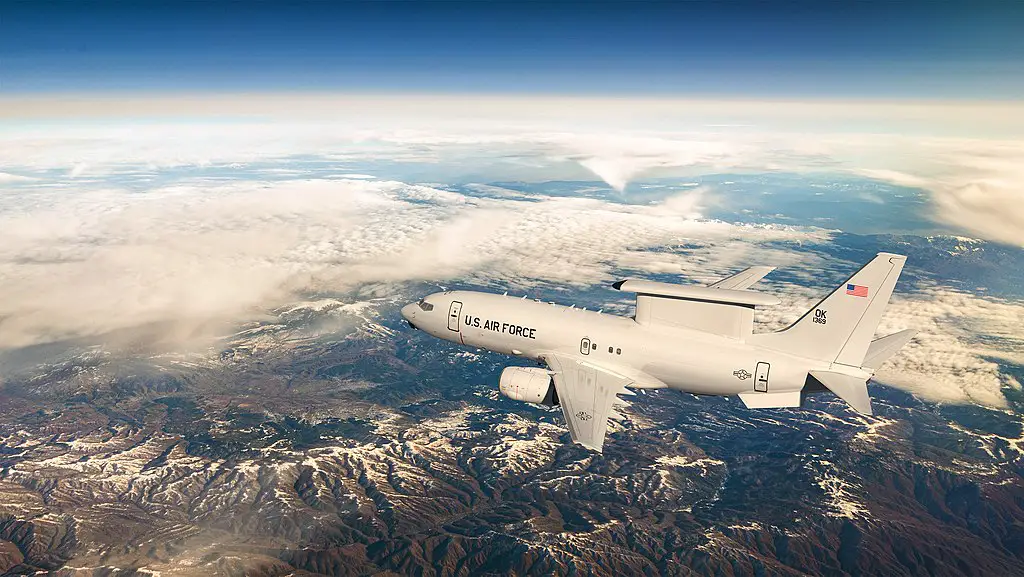Boeing has been awarded a $2.56 billion contract from the U.S. Air Force for two rapid prototype E-7A AEW&C Wedgetail aircraft. The contract includes lifecycle development, training and support for the Air Force’s E-7A fleet. The combat-proven E-7A Wedgetail provides targeted tracking and battle management command-and-control capabilities to joint forces for “first to detect, first to engage” advantage. The E-7 AEW&C platform is currently in service with the Royal Australian Air Force, Republic of Korea Air Force (designated E-737 Peace Eye) and Turkish Air Force (designated E-7T Peace Eagle). Built on the Boeing 737-700 NG airframe, the E-7 AEW&C aircraft offers lower operating and sustainment costs, higher mission readiness rates and unmatched interoperability among a growing global user community.
“Our customers have an urgent need for integrated battlespace awareness and battle management. The E-7A is the airspace lynchpin to continuously scan the skies, command and control the battlespace, and integrate all-domain data providing a decisive advantage against threats. With our open systems architecture approach, capabilities can be rapidly inserted over time as threats evolve,” said Dan Gillian, vice president and general manager of Boeing Defense, Space & Security’s Mobility, Surveillance & Bombers division.
“Global operators are proving that the E-7 AEW&C is a critical node for air superiority in the modern battlespace. In our partnership with the U.S. Air Force, we’re focused on stable, predictable execution to deliver crucial mission-ready capabilities today. This will put us on the path for the long-term growth of the aircraft and mission,” said Boeing Vice President and E-7 Program Manager Stu Voboril.

The Boeing E-7 Wedgetail is a twin-engine airborne early warning and control aircraft based on the Boeing 737 Next Generation design. It has a fixed, active electronically scanned array radar antenna instead of a rotating one as with the 707-based Boeing E-3 Sentry. In addition to the rapid prototype E-7A AEW&C aircraft being built for the U.S. Air Force, Boeing is currently producing three E-7As for the Royal Air Force, with military modifications underway in the United Kingdom. Additionally, NATO has selected the E-7A as its preferred AEW&C solution. Together, the Royal Air Force, Royal Australian Air Force and U.S. Air Force have a Wedgetail tri-lateral cooperation agreement relating to E-7 aircraft capability development, evaluation and testing, interoperability, sustainment, operations, training and safety.
On 26 April 2022, the U.S. Air Force announced that the E-7 would replace the E-3 as it “is the only platform capable of meeting the requirements for the Defense Department’s tactical battle management, command and control and moving target indication capabilities within the timeframe needed. An initial $1.2 billion contract was awarded in 2023 to develop two new US-specific variants of the E-7. The 737 AEW&C uses the Northrop Grumman Electronic Systems Multi-role Electronically Scanned Array (MESA) radar. The electronically scanned AEW and surveillance radar is located on a dorsal fin on top of the fuselage, dubbed the “top hat”, and is designed for minimal aerodynamic effect. The radar is capable of simultaneous air and sea search, fighter control and area search, with a maximum range of over 600 km (look-up mode). In addition, the radar antenna array also serves as an ELINT array, with a maximum range of over 850 km at 9,000 metres (30,000 ft) altitude. Radar signal processing equipment and a central computer are installed directly below the antenna array.
















